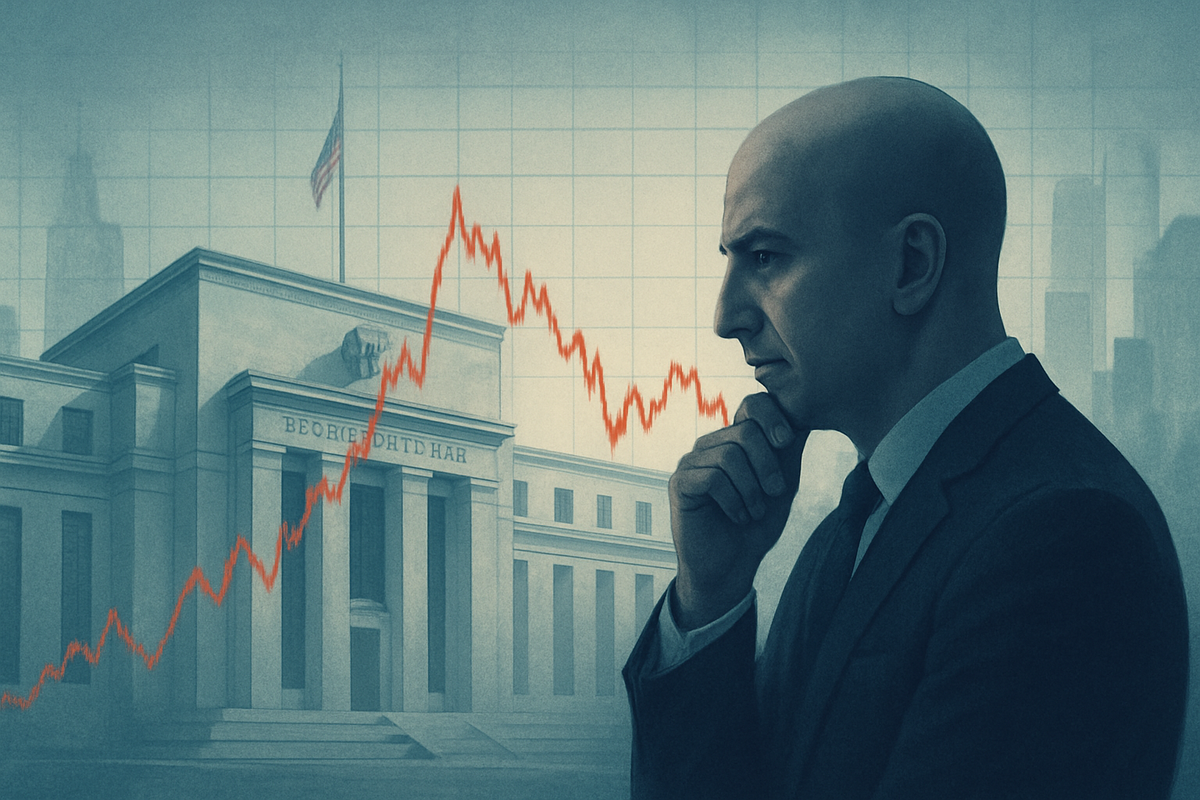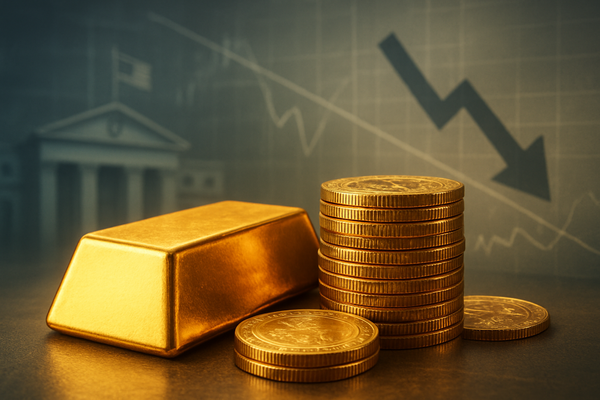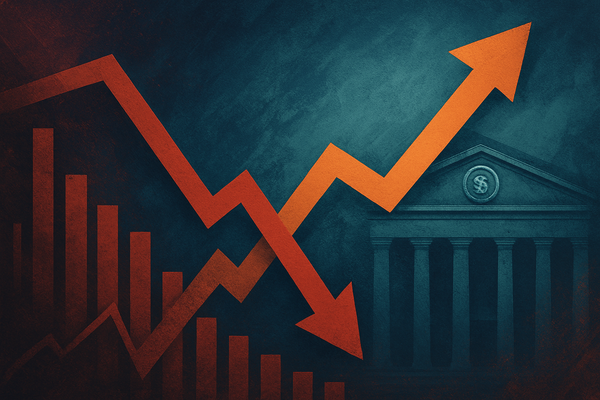Kashkari's Hawkish Stance Casts Shadow on Future Fed Rate Cuts, Signals Higher Bar for Easing

Minneapolis Federal Reserve President Neel Kashkari has emerged as a prominent voice of caution within the Federal Reserve, explicitly dissenting from the central bank's most recent interest rate cut and maintaining an undecided stance on a potential December 2025 reduction. His position, characterized by concerns over persistent inflation at 3% and mixed economic signals, suggests a higher hurdle for future monetary easing. Kashkari's hawkish lean signals a potential shift in the Fed's policy direction, emphasizing data-driven decisions and a flexible approach rather than a preset course of rate cuts. This divergence in views within the FOMC could lead to more cautious and deliberative policy adjustments in the coming months, impacting market expectations and economic stability.
A Lone Wolf's Dissent: Unpacking Kashkari's Cautious Stance
Neel Kashkari's recent dissent from the Federal Reserve's latest interest rate cut, and his current indecision regarding a December 2025 reduction, highlight a growing cautiousness within certain factions of the central bank. As of November 13, 2025, Kashkari has openly stated his opposition to the most recent rate cut, citing anecdotal evidence and data that suggested continued resilience in economic activity. He believes this resilience warranted a pause in rate cuts at the time of the Federal Reserve's October meeting, and subsequent data has only reinforced his view of "more of the same" for the economy.
This recent hawkish turn marks a notable shift from his stance in September 2025, when he supported a quarter-point cut to the key interest rate. At that time, Kashkari identified a rebalancing of risks, moving from higher inflation towards a greater concern for unemployment, which he felt justified a lower federal funds rate. However, he simultaneously cautioned against a "preset course" for rate cuts, stressing the importance of flexibility and the willingness to raise rates if economic conditions dictated. His current undecided position for the December 2025 meeting is rooted in ongoing concerns about inflation, which he notes remains "too high at 3%," coupled with "mixed signals" emanating from various economic indicators.
Key players involved in this ongoing debate include the entire Federal Open Market Committee (FOMC), whose collective decisions shape the nation's monetary policy. Kashkari's voice, while a single vote, represents a significant perspective that could sway future policy discussions. Initial market reactions to such dissenting views often include increased volatility, particularly in interest-rate-sensitive sectors, as traders attempt to price in a potentially more hawkish Fed. The bond market, in particular, may see yields adjust upwards as expectations for aggressive rate cuts diminish. Kashkari's persistent mention of tariffs as a "stagflationary shock" also adds another layer of complexity, suggesting that trade policy continues to be a significant consideration for monetary policy decisions, potentially increasing the hurdle for rate adjustments.
Market Movers: Companies Poised to Win or Lose from a Hawkish Fed
Neel Kashkari's hawkish stance and the potential for a slower pace of rate cuts, or even a pause, could significantly impact various public companies and sectors. Industries sensitive to interest rate fluctuations will be particularly affected, creating both winners and losers in the current economic climate.
On the losing side, companies heavily reliant on borrowing for expansion or consumer spending financed by credit could face headwinds. The real estate sector, including homebuilders like D.R. Horton (NYSE: DHI) and Lennar Corporation (NYSE: LEN), along with real estate investment trusts (REITs) such as Simon Property Group (NYSE: SPG), could see dampened demand as mortgage rates remain elevated or even rise. Higher borrowing costs for developers can also slow down new projects. Similarly, growth stocks, often found in the technology sector, which are valued on future earnings potential, tend to suffer when interest rates are higher. Companies like Salesforce (NYSE: CRM) or Snowflake (NYSE: SNOW), which might rely on easily accessible capital for innovation and expansion, could experience pressure on their valuations as the discount rate for future cash flows increases. Additionally, consumer discretionary companies like Starbucks (NASDAQ: SBUX) or Nike (NYSE: NKE) might see reduced sales if higher interest rates lead to tighter consumer budgets and reduced spending on non-essential goods and services.
Conversely, a more hawkish Fed, prioritizing inflation control, could create winners. Banks and financial institutions often benefit from higher interest rates, as their net interest margins – the difference between what they earn on loans and pay on deposits – typically expand. Large banks such as JPMorgan Chase (NYSE: JPM) and Bank of America (NYSE: BAC) could see increased profitability. Furthermore, value stocks and companies with strong, stable cash flows, less dependent on future growth projections, might become more attractive to investors seeking refuge from interest rate volatility. Companies with low debt levels or those that generate significant free cash flow will also be better positioned to weather an environment of higher borrowing costs. Finally, sectors that are traditionally seen as defensive, such as utilities like Duke Energy (NYSE: DUK) or consumer staples like Procter & Gamble (NYSE: PG), might also see increased investor interest as their stable dividends and consistent demand offer a safe haven during periods of economic uncertainty and higher rates.
Broader Implications: A Shift in Fed's Policy Compass?
Neel Kashkari's dissenting vote and his wavering stance on future rate cuts signal a potentially significant shift in the Federal Reserve's broader policy direction, moving towards a more cautious and data-dependent approach. This aligns with a growing sentiment among some Fed officials who prioritize combating persistent inflation over immediate economic stimulus, especially with inflation still hovering at 3%. This perspective suggests that the Fed might be willing to tolerate slower economic growth or a slightly softer labor market if it means achieving its 2% inflation target.
The potential ripple effects on competitors and partners within the global financial landscape are substantial. If the U.S. Fed maintains a higher interest rate environment than other major central banks, it could strengthen the U.S. dollar. A stronger dollar makes U.S. exports more expensive and imports cheaper, potentially impacting the competitiveness of American multinational corporations like Apple (NASDAQ: AAPL) and Boeing (NYSE: BA) in international markets. Conversely, it could benefit foreign companies exporting to the U.S. Regulatory and policy implications also loom large; a more hawkish Fed might prompt closer scrutiny from policymakers on fiscal spending, as aggressive government outlays could counteract the Fed's efforts to cool the economy.
Historically, periods of persistent inflation have often led to more aggressive tightening cycles by central banks. Comparing Kashkari's current stance to past Fed officials who advocated for tighter monetary policy during inflationary pressures, such as Paul Volcker in the early 1980s, highlights the gravity of the current situation. While not as extreme, Kashkari's emphasis on avoiding a "preset course" and his willingness to raise rates if warranted echoes the lessons learned from previous eras where central banks were criticized for being too slow to react to inflationary pressures. This suggests the Fed is acutely aware of the risks of allowing inflation to become entrenched, even if it means diverging from market expectations for continuous rate cuts.
The Road Ahead: Navigating Uncertainty and Emerging Opportunities
The path forward for the Federal Reserve, particularly in light of Neel Kashkari's hawkish stance, is characterized by increased uncertainty and a heightened focus on incoming economic data. In the short term, markets will be closely watching inflation reports, labor market data, and consumer spending figures to gauge the likelihood of a December rate cut. If inflation remains stubbornly high or shows signs of re-accelerating, Kashkari's position could gain more traction within the FOMC, making a December cut less probable. Conversely, a significant deterioration in labor market conditions or a sharp slowdown in economic growth might pressure the Fed to lean towards easing, despite Kashkari's reservations.
In the long term, Kashkari's emphasis on avoiding a "preset course" suggests a more agile and less predictable monetary policy. This could mean that the Fed will be quicker to respond to evolving economic conditions, potentially leading to more frequent, albeit smaller, policy adjustments rather than extended periods of either aggressive tightening or easing. Potential strategic pivots for businesses will involve strengthening balance sheets, reducing reliance on variable-rate debt, and focusing on operational efficiencies to withstand higher borrowing costs. Companies with strong pricing power in their respective markets may also be better positioned to pass on increased costs without significantly impacting demand.
Market opportunities may emerge in sectors that benefit from a stable, albeit higher, interest rate environment, such as financial services and certain defensive industries. Conversely, challenges will persist for highly leveraged companies and those in cyclical sectors sensitive to economic slowdowns. Potential scenarios range from a "soft landing" where inflation gradually recedes without a severe recession, to a more challenging "stagflationary" environment if inflation persists alongside sluggish growth, a scenario Kashkari has alluded to with his concerns about tariffs. The ultimate outcome will depend on the interplay of various economic factors and the Fed's ability to navigate these complex trade-offs.
Wrap-Up: A Cautious Outlook Amidst Evolving Economic Realities
Neel Kashkari's dissenting view on the last rate cut and his undecided stance on a December 2025 reduction are pivotal indicators of the Federal Reserve's evolving monetary policy landscape. The key takeaway is a clear signal that the Fed may be adopting a more cautious and data-dependent approach, with a higher bar for future rate cuts, driven by concerns over persistent inflation and mixed economic signals. This marks a departure from expectations of a continuous easing cycle, suggesting that the era of readily available cheap capital might be giving way to a more disciplined financial environment.
Moving forward, the market is likely to experience increased volatility as investors recalibrate their expectations for interest rates. The focus will squarely be on economic data, particularly inflation metrics and labor market reports, which will heavily influence the Fed's next moves. Companies with robust balance sheets, strong cash flows, and those in less interest-rate-sensitive sectors are likely to fare better, while highly leveraged firms and growth-oriented businesses may face continued pressure.
The lasting impact of Kashkari's hawkish perspective could be a more pragmatic and less predictable Federal Reserve, one that is prepared to deviate from market consensus in its pursuit of price stability. Investors should meticulously watch for any shifts in FOMC rhetoric, the tone of upcoming economic forecasts, and most importantly, the actual trajectory of inflation and employment figures in the coming months. These will be the ultimate determinants of the Fed's policy path and, by extension, the broader market's direction.
This content is intended for informational purposes only and is not financial advice



